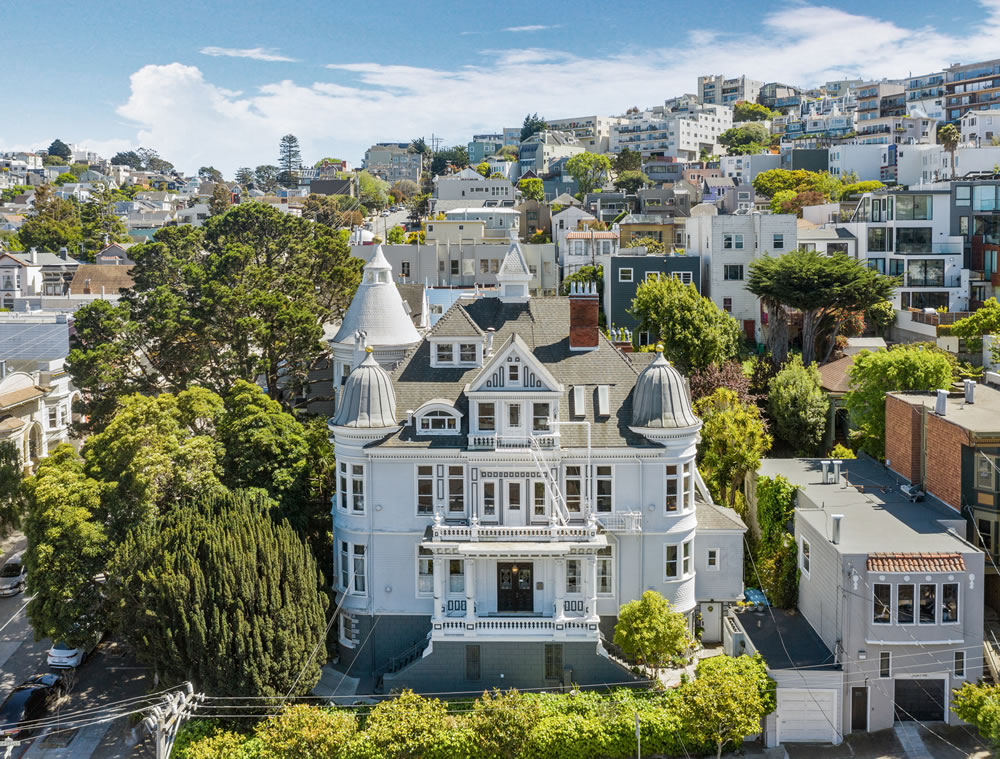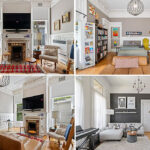Known as “Nobby Clarke’s Folly” back in the day, the 8,395-square-foot Alfred E. Clarke Mansion at 250 Douglass Street, which occupies the southwest corner of Caselli Avenue in Eureka Valley/Corbett Heights, is now on the market with a $5.85 million price tag.
Built for Alfred “Nobby” Clarke on the easterly boundary of a 17-acre tract acquired by Clarke in 1891, the four-story mansion, which was designed by Gould & Colley and landmarked by the City of San Francisco in 1975, features an eclectic collection of both Queen Anne and Colonial Revival details, with flamboyant towers, gables, dormers and shingle designs.
Born in Ireland, Clarke arrived in San Francisco in 1850 at the age of 17 and secured a position as a patrolman on the city’s police force in 1856 along with a reputation for violence, including one incident in which a suspect retaliated, permanently disfigured Clarke’s hand and resulted in the “Nobby” nickname.
Moved to a desk job, Clarke served as a clerk to the chief of police, during which time he studied law, and became the chief legal advisor to the chief of police.
And when Clarke resigned from the force in 1887, he had amassed an estimated net worth of around $200,000, which is twice as much as the mansion cost to build, having established a “money lending service” for fellow officers and other city employees at usurious rates during his tenure on the force (and for which he was suspended for a few years).
Clarke went bankrupt in the Depression of the 1890s and was forced to sell the mansion, which he had mortgaged, to the faculty of the California Medical College in 1896.
The mansion served as a small teaching hospital for the Medical College until 1901, was home to the California General Hospital from 1901 to 1906 and then Jefferson Hospital for two years.
In 1909, the mansion was then converted into 15 apartments, with five (5) studios, seven (7) one-bedrooms and three (3) two-bedrooms, as it is currently configured, with a throwback entry/foyer and updated kitchens, baths and unit interiors.
And with its lot having been whittled down over the years to 0.191 acres, but with a stand-alone cottage and a one-car garage as well, the property is currently generating around $394,409 in annual rents, for a CAP rate of 3.75 percent as currently priced and fully occupied.



It’s been roont. What a shame.
It’s been converted to actually be enjoyed for what it’s worth. There is no purpose to a mansion like this serving as an individual residence.
Was it roont in 1896 when it was converted into a teaching hospital, or in 1909 when it was converted again into apartments?
This is the type of property that can easily bankrupt an investor…
Its a great-looking building but I don’t understand the attraction of something like this as an investment at this cap rate — it looks finicky to maintain and the city and the neighbors will be all over you the minute you need to touch anything on the exterior.
Would be surprised if the marketing cap rate includes the true costs of maintaining this building. All that, combined with tenants who will live there until they die seems to make this a ‘folly’ indeed….
The average tenancy in the building is currently running around 11 years, which isn’t too much longer than the average length of tenancy for rent controlled units in the city (and despite the bogeyman of every rental resulting in a de facto life estate).
The average tenancy doesn’t tell an investor what they really need to know: Given the duration of the tenancy of each of the below-market units, what is the probability that they will become vacant and go up to market rate in the near future?
Just because the present building has an average tenancy that is about equal to the city-wide average for rent-controlled units, this does not mean that ‘time’s up’ for this building so that it soon empties out and gives the investor-purchaser the opportunity to capture market-rate rents. In fact, what’s likely to happen is the opposite — nobody leaves.
The average tenancy number for the city includes many recently-rented units that will have shorter tenancies (since the tenants are paying close to market rates) and hides a large number of deeply under-market units that will take a very long time to turnover.
The upshot: If you are listing a rent-controlled unit for rent now, you can reasonably expect that the new tenant will leave well before the 11-year average. But, if you have a unit with a below-market tenant, you should be prepared for them to stay for the rest of their lives.
But around1905, the editor is saying that the average tenancy *in this very building* is running around 11 years; not that we should expect that length of tenancy based on a city average. So what is your basis for assuming that a new buyer of this building should expect lifetime tenancies rather than the11-year tenancies that *this building* currently averages?
The 11-year average tenancy in SF rent-controlled buildings is backward-looking. It says little about how long a tenancy you should expect for a unit that has been occupied for a number of years.
Here’s an example. The average life exptectancy in the US today is around 77 years. But, if you are already 77 years-old, your life expectancy is actually another 10 years.
In the case of these rent-controlled units, I think its more extreme. In other words, a unit that has been occupied for 11 years is likely to remain occupied by the same tenant for many more years. This is consistent with the 11-year average tenancy in SF because units occupied for, say 5 years, are quite likely to turn over soon (especially in light of the recent drop in rental prices).
My overall point is that these kinds of buildings, at best, function like a partially-inflation-indexed bond. The SF rent board allows you to increase rents at 2/3 their stated rate of inflation. Property taxes go up at a max of 2% per year. Maintenance expenses follow inflation (or more). In the case of this building, those maintenance expenses are going to be higher than the numbers implied in marketing literature. So do your math, and take your chances, but don’t’ assume any turnover allowing your rents to track the local market or inflation fully.
What is the average tenancy for a rent controlled unit? Is that the median or the mean?
Would this be eligible for a conversion back to a SFH? I could see a crypto / steampunk / goth who made it big in the latest Bitcoin bull run turning this into their playground.
Absolutely no chance of that ^ ever happening.
Yes, it’s a complete daydream of an idea. However, I know some Victorian-loving, steampunk-ish tech people who I could see going go all-in on period piece Victorian home.
How unfortunate that you know people like that. They sound smug, narcissistic and awful.
At least the conversion to apts didn’t destroy everything. Gonna make a point to walk by it someday soon.
I love that this building is still here, and love that it is configured for 15 real households instead of some billionaire’s pied-a-terre.
Armistead Maupin lived there for a bit. A note to all the people eagerly prattling about investor returns: you’re ruining everything. This house is not about that. I am sad that they can’t TIC it among its tenants. It would make a great co-op.
What is stopping the tenants from doing that? Nothing, other than their lack of desire, or possibly the funds. My guess is its the former not the latter
And what is that guess based on?
Yeah, why would any renter want to have to pay for the mortgage (average per unit sales price $390,000)
Mortgage payment $1,933
Property taxes $390
HOA dues $300
Homeowners’ insurance $150
Total -> $2733/month
Why would any tenant take on that responsibility when they can just scream evil landlord and not be responsible for anything?
I have been in my studio apartment for 50 years as of 2021. Like some of those people in this former mansion they probably can’t afford to leave even if they wanted to. ( I voted against rent control and am benefiting big time from it). From the photos I am amazed at how nice the apartments are. Most of the glory of the former mansion is still intact! Amazing.
Wow. 50 years! May I ask which neighborhood and how much you pay in rent?
Old photos of it: under construction, circa 1957.